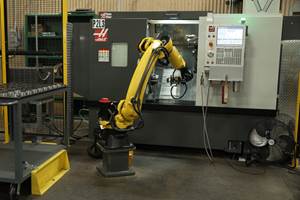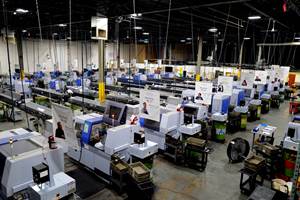Old Machines Are Also Automation Candidates: 40-Year-Old Machine Adapted into Unattended System
Integrating an automatic positioner with a formerly manual jig borer brings increased efficiency to secondary operations.
Share





Ask a manufacturer to point out its automated production system, and you are likely to see the most modern and advanced system at work in the shop. Perhaps that automated system consists of a robot loading and unloading an advanced machining center or multitasking lathe. On the other hand, , the supplier of material positioning equipment, makes a case for the automation of dated machinery as well—including pieces of equipment that otherwise might be forgotten. An example of this is part of the company’s own production process: a circa 1973 jig borer that has been adapted into a system for ongoing unattended production.
The jig borer, which paid for itself long ago, had been used less and less over time within TigerStop’s manufacturing facility in Vancouver, Washington. It recently found new life in its secondary-operation role when the facility mated it to one of the company’s own products: an automated positioner for metalworking operations called the TigerRack. This positioner pushes with a 720-pound force to move stock including metal plate and tubing. In the jig borer application, it repetitively advances steel stock that is machined into face plates for this very positioner model.
The jig borer performs drilling and chamfering operations. Of course, this was not an automated machine in the past. TigerStop’s team sees that very fact as a valuable one, illustrating one of the central ideas the company seeks to advance: Namely, there are chances to automate beyond a shop’s CNC machines.
An interconnection kit available for the positioner system makes automation possible. The kit connects to a relay logic box, which synchronizes the material feed with the motion of the non-CNC machine’s air cylinder. Thus, in operation, the spindle moves up out of the way of the work as the positioner advances the stock to the next position within 0.008-inch accuracy, at which point the spindle moves back down to make the cut. The operator can walk away and leave the machine producing. This delivers significant savings, because past drilling and chamfering operations required active employee participation for loading parts and initiating the cuts. The process now looks like this:
To be sure, this facility also has CNC equipment, and more productive use of this equipment is actually one of the benefits the company is seeing thanks to the automation of this secondary process. In theory, it has always been possible to drill and chamfer parts while a cycle was running on the machining center, but in practice the machinist can never quite break away from this task with the kind of timing that is perfectly synched to the completion of the machining center cycle. Being able to trust the drilling and chamfering work to continue means the machinist is always ready to change over the higher-value machine tool when the moment comes.
Material cost savings is also a noticeable factor. In the past, scrap happened—mistakes are inevitable in any process run by people. The virtue of a proven, repetitive, automated process is not just the freedom from labor cost, but also the freedom from human error.
CNC obviously could deliver these benefits as well. So why not just do the drilling and chamfering within the machining center? TigerStop says the answer is that these operations are too simple. The higher-value machine ought to be devoted to higher-value work. That is the reason these secondary operations were assigned to an older piece of equipment in the first place. And yet, lower-value does not mean lower-impact—secondary operations should not be overlooked. There are automation opportunities within this work as well.
Related Content
Which Approach to Automation Fits Your CNC Machine Tool?
Choosing the right automation to pair with a CNC machine tool cell means weighing various factors, as this fabrication business has learned well.
Read MoreStuder's Automation, Entry-Level Solutions Take Center Stage
At its 2024 Music Motion Meeting, Studer AG showed off its entry-level line of grinding machines, as well as its newest universal loading system.
Read MoreSetting Up the Building Blocks for a Digital Factory
Woodward Inc. spent over a year developing an API to connect machines to its digital factory. Caron Engineering’s MiConnect has cut most of this process while also granting the shop greater access to machine information.
Read MoreInside the Premium Machine Shop Making Fasteners
AMPG can’t help but take risks — its management doesn’t know how to run machines. But these risks have enabled it to become a runaway success in its market.
Read MoreRead Next
AMRs Are Moving Into Manufacturing: 4 Considerations for Implementation
AMRs can provide a flexible, easy-to-use automation platform so long as manufacturers choose a suitable task and prepare their facilities.
Read MoreMachine Shop MBA
Making Chips and 91ÊÓƵÍøÕ¾ÎÛ are teaming up for a new podcast series called Machine Shop MBA—designed to help manufacturers measure their success against the industry’s best. Through the lens of the Top Shops benchmarking program, the series explores the KPIs that set high-performing shops apart, from machine utilization and first-pass yield to employee engagement and revenue per employee.
Read More






















